The Intel Optane SSD 900p 480GB Review: Diving Deeper Into 3D XPoint
by Billy Tallis on December 15, 2017 12:15 PM ESTSequential Read Performance
Our first test of sequential read performance uses short bursts of 128MB, issued as 128kB operations with no queuing. The test averages performance across eight bursts for a total of 1GB of data transferred from a drive containing 16GB of data. Between each burst the drive is given enough idle time to keep the overall duty cycle at 20%.
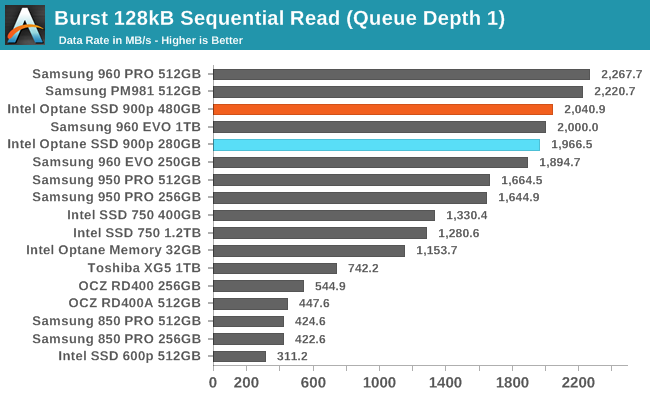
Despite having incredibly low access latency, the Optane SSD 900p doesn't beat the fastest flash-based SSDs in our burst sequential read test. The fastest flash SSDs make up for their slower initial response time through a combination of higher channel counts, prefetching and most likely larger native block sizes. The Optane SSD 900p still has a great score here, but it fails to stand out from the much cheaper flash-based drives.
Our test of sustained sequential reads uses queue depths from 1 to 32, with the performance and power scores computed as the average of QD1, QD2 and QD4. Each queue depth is tested for up to one minute or 32GB transferred, from a drive containing 64GB of data.
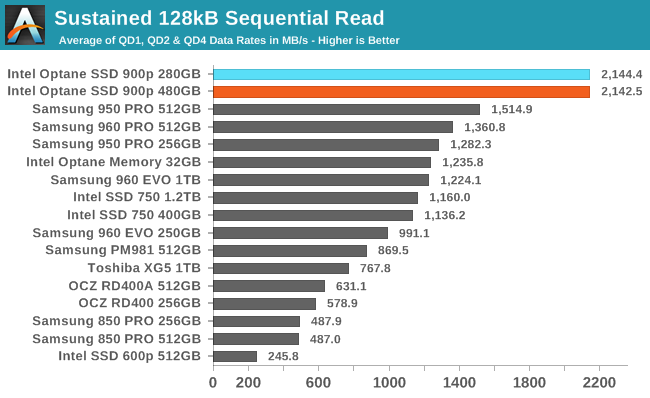
With the test of higher queue depths and longer run times, the Optane SSDs are back on top with a substantial performance lead. Unlike the burst test, this test shows almost no performance difference between the two capacities of the Optane SSD 900p.
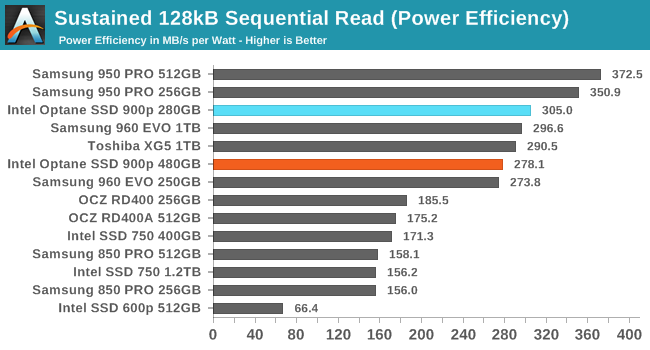
The performance lead of the Optane SSD 900p isn't enough to make up for its higher power consumption, so the 900p ends up in the second tier of drives for sequential read power efficiency, alongside Samsung's 960 generation and the Toshiba XG5.
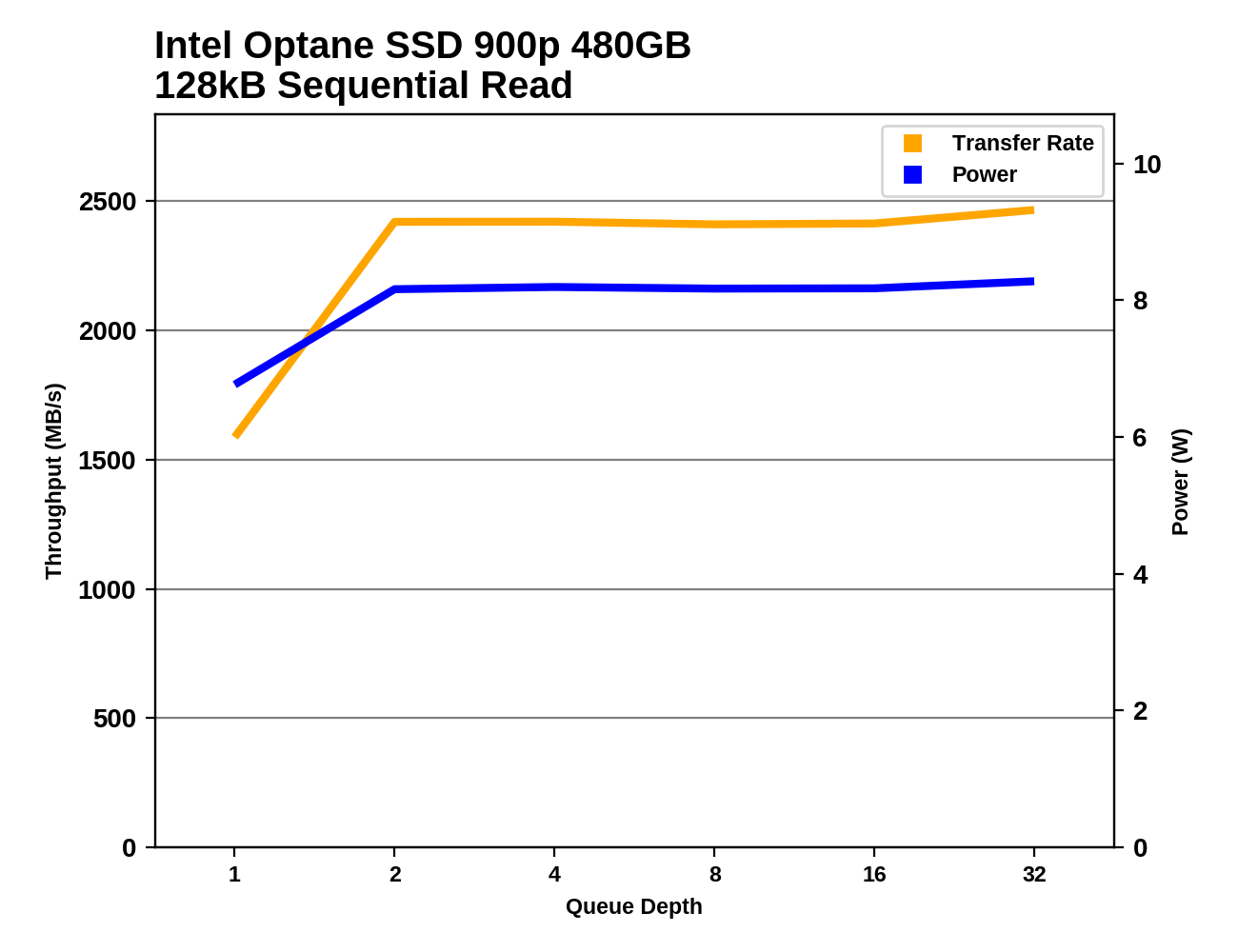 |
|||||||||
The 480GB Optane SSD 900p draws about 0.6–0.75W more than the 280GB model during the sequential read test, putting it just over 8W total when operating at full speed. Even the smaller 900p is still over 6W at QD1, while the flash-based SSDs are mostly in the 4-5W range. (The Intel SSD 750 breaks 9W at higher queue depths.)
Sequential Write Performance
Our test of sequential write burst performance is structured identically to the sequential read burst performance test save for the direction of the data transfer. Each burst writes 128MB as 128kB operations issued at QD1, for a total of 1GB of data written to a drive containing 16GB of data.
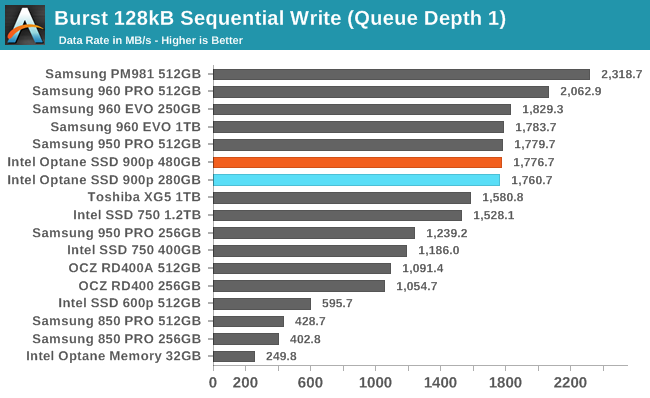
The burst sequential write performance of the Intel Optane SSD 900p is on par with some of Samsung's older NVMe SSDs, but is exceeded by the 960 generation and the PM981.
Our test of sustained sequential writes is structured identically to our sustained sequential read test, save for the direction of the data transfers. Queue depths range from 1 to 32 and each queue depth is tested for up to one minute or 32GB, followed by up to one minute of idle time for the drive to cool off and perform garbage collection. The test is confined to a 64GB span of the drive.
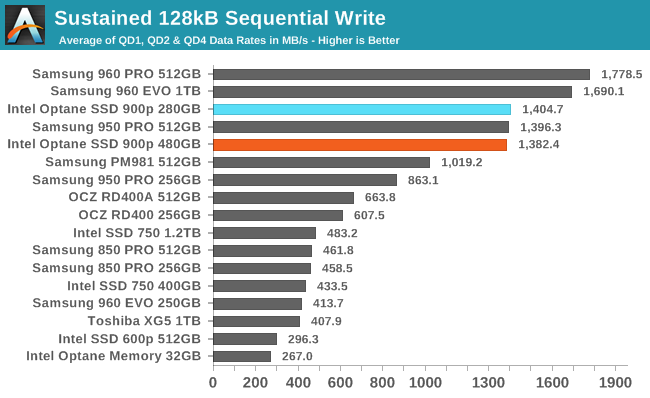
On the longer sequential write test, the Samsung PM981 falls out of first place and ends up substantially slower than the Optane SSD 900p, but the Samsung 960 PRO and EVO are still faster than the 900p.
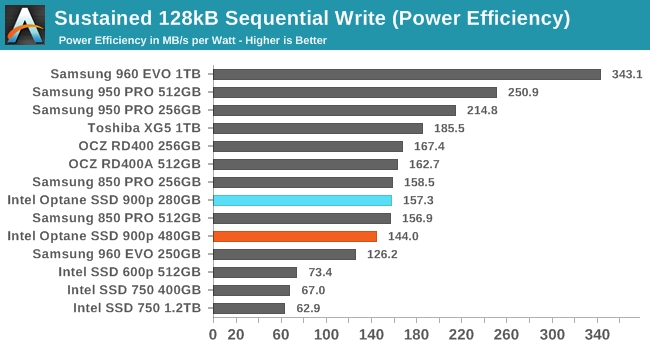
The power efficiency of the Optane SSD 900p during sequential writes is worse than most M.2 NVMe SSDs, though not as bad as the extremely power-hungry Intel SSD 750.
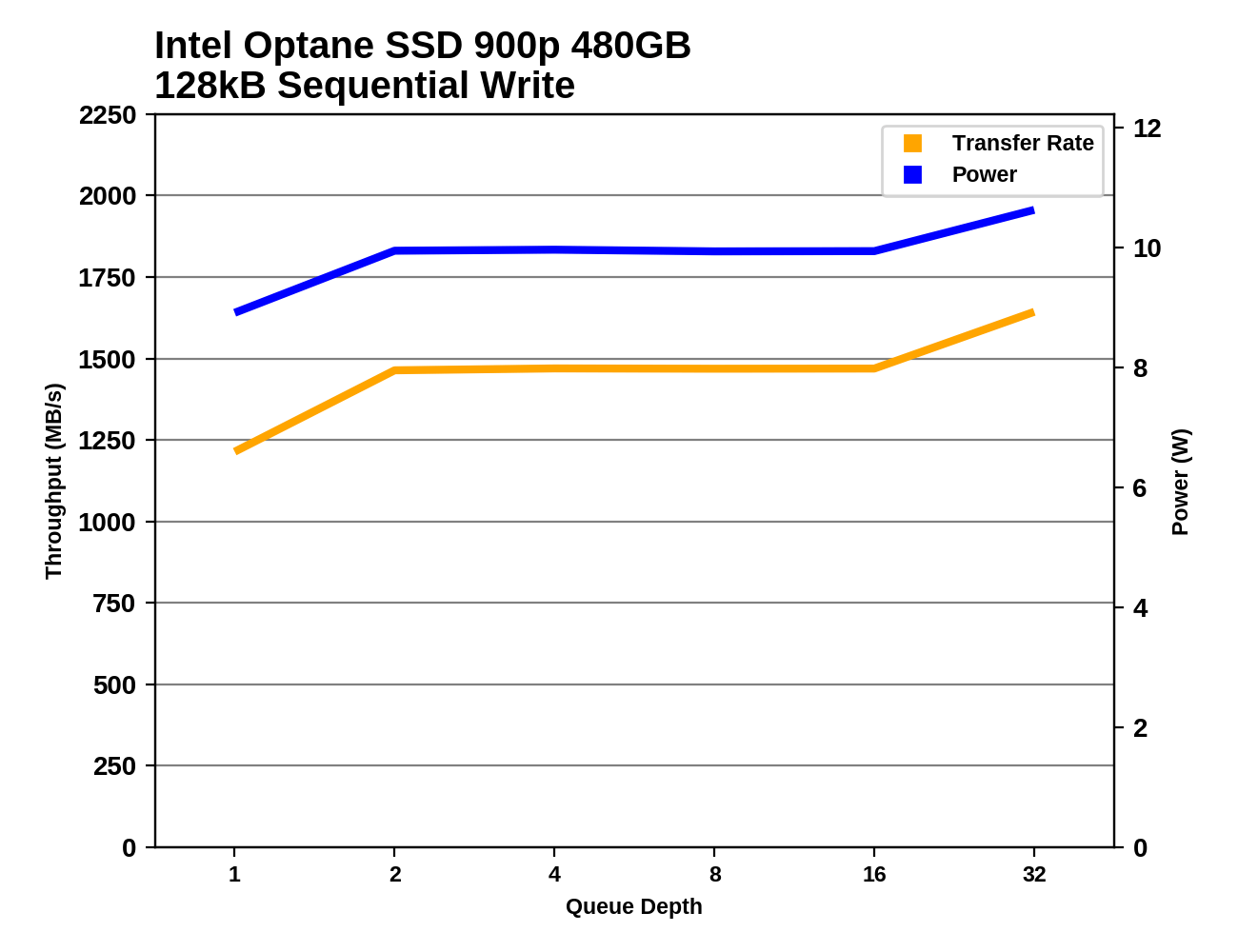 |
|||||||||
The two capacities of the Optane SSD 900p offer essentially identical sequential write performance. As with sequential reads, the difference in power consumption between the two capacities is about 0.75W, but the writes require about than 2W more than the reads.










69 Comments
View All Comments
nathanddrews - Friday, December 15, 2017 - link
Is there any indication that performance would degrade with a lesser CPU or improve with a faster CPU? Just curious if we should expect CPU bottlenecks from these hyper-speed SSDs.Billy Tallis - Friday, December 15, 2017 - link
Yes, CPU speed can definitely affect latency and consistency and maximum achievable IOPS. Some of those limits were hit with the P4800X testing on a server with lower per-core performance than this consumer testbed.At the moment, my inclination is to leave the consumer test suite single-threaded, because consumer workloads don't actually hit the queue depths necessary to go beyond the I/O capabilities of a single CPU core. I don't care too much if the high QD range on some of the graphs doesn't quite reach the theoretical limit of the drive, because that's not the part of the graph we should be paying attention to. (For consumer drives.)
At low queue depths, interrupt servicing latency can be helped a bit by a faster CPU. But for most consumers, switching from Windows to Linux will do a lot more to help reduce their storage latency. And saving a few more microseconds only matters on Optane; mainstream products won't be this fast for quite a while.
ddrіver - Friday, December 15, 2017 - link
I think I'll have to reevaluate my position on Optane. Seems like a solid product. Guess I misread the signs.ddriver - Friday, December 15, 2017 - link
How can you tell a fake "ddriver" apart? Well, the real one would never mislabel the product hypetane ;)It is what it is, and still nowhere nearly "1000x" better as intel claimed. It has its niche strengths, but those offer no tangible benefit to 99.9999% of the consumers out there. I don't recall ever claiming that it will suck, my claim has always been that it will epically fail to live up to the hype, which testing thoroughly confirms. It is not even 10% of "1000x better". So hypetane it is.
SLC flash can easily match and even bet it in most performance metrics. Unfortunately the industry is not even trying, even mlc is now considered "ultra high end enterprise". Which is understandable, as the workloads that could actually benefit from higher performance are very few and far in between, and for 99% of them using ram is the more applicable and still tremendously better performing solution.
It is definitely not a bad product on its own. And I would not refer to it as "hypetane" if only intel hadn't shamelessly lied about it on such a preposterous scale.
tuxRoller - Friday, December 15, 2017 - link
Interface speeds≠ media speedsWhen will you learn?
Also, still need a reference for those SLC numbers.
LordanSS - Saturday, December 16, 2017 - link
Indeed, Interface speeds are not "media" speeds. I never expected it to work according to Intel's "1000x" claims, but was hoping for a more in-line 20x better from what we currently have, considering first generation product and all.And it doesn't even do that. Sorry, for this one time, I am (partially) siding with ddriver.
lmcd - Saturday, December 16, 2017 - link
20X better overall is entirely unrealistic. Certain attributes are 20X better. That is all you can really expect when so many things (form factor, power usage, interface protocols, physical interface, etc) are retained from the previous generation.LordanSS - Sunday, December 17, 2017 - link
20x is 2% (TWO PERCENT) of what Intel claimed when they disclosed XPoint. It's not realistic?Intel shoul have kept their mouth shut back then, just like Micron has done so until now. If they can't even do 2% of what they claimed, they're the unrealistic ones.
tuxRoller - Sunday, December 17, 2017 - link
Were those claims that Intel made in reference to xpoint the tech, or optane the first gen product?tuxRoller - Saturday, December 16, 2017 - link
I'm not sure why you are quoting media, but you are absolutely welcome to be disappointed.You'll notice I don't care whether anyone thinks Intel over hyped their product only that we still don't know what the actual xpoint (the media, or "tread + xfer + Misc" times, as Handy refers to it) response times look like.
If AT doesn't allow the below link, search for "xpoint presence in slow lane explained" on the register, or Google "Why XPoint SSDs won't meet original speed claims: A guide"
https://www.theregister.co.uk/2016/09/29/xpoint_pr...